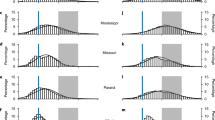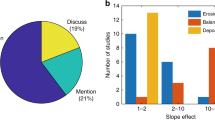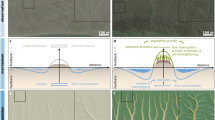Abstract
The morphologies of the world’s deltas are thought to be determined by river discharge, tidal range and wave action 1. More recently, sea-level rise 2,3 and human engineering4 have been shown to shape delta evolution. The effects of factors such as sediment type and the overall amount of sediment carried by rivers are considered secondary4,5,6. In particular, the role of sediment cohesion, which is controlled by sediment size and type of vegetation, is unclear. Here we use a numerical flow and transport model7,8,9,10 to show that sediment cohesiveness also strongly influences the morphology of deltas. We find that, holding all other factors constant, highly cohesive sediments form bird’s-foot deltas with rugose shorelines and highly complex floodplains, whereas less cohesive sediments result in fan-like deltas with smooth shorelines and flat floodplains. In our simulations, sediment cohesiveness also controls the number of channels that form within the deltas, and the average angle of bifurcation of those channels. As vegetation generally acts as a cohesive agent, we suggest that deltas that formed before the expansion of land plants in the Devonian period should show fan-like characteristics, a finding consistent with the limited data from the sedimentological record11.
This is a preview of subscription content, access via your institution
Access options
Subscribe to this journal
Receive 12 print issues and online access
$259.00 per year
only $21.58 per issue
Buy this article
- Purchase on Springer Link
- Instant access to full article PDF
Prices may be subject to local taxes which are calculated during checkout



Similar content being viewed by others
Change history
20 January 2010
In the version of this Letter initially published online, the cell size given in the second paragraph of the Methods should have been 625 m2. This error has been corrected in all versions of the text.
References
Galloway, W. E. in Deltas: Models for Exploration (ed. Broussard, M. L.) 87–98 (Houston Geological Society, 1975).
Jerolmack, D. J. Conceptual framework for assessing the response of delta channel networks to Holocene sea level rise. Quart. Sci. Rev. 28, 1786–1800 (2009).
Giosan, L. et al. Young Danube delta documents stable Black Sea level since the middle Holocene: Morphodynamic, paleogeographic, and archaeological implications. Geology 34, 757–760 (2006).
Syvitski, J. P. M. et al. Sinking deltas due to human activities. Nature Geosci. 2, 681–686 (2009).
Orton, G. J. & Reading, H. G. Variability of deltaic processes in terms of sediment supply, with particular emphasis on grain size. Sedimentology 40, 475–512 (1993).
Syvitski, J. & Saito, Y. Morphodynamics of deltas under the influence of humans. Glob. Planet. Change 57, 261–282 (2007).
Lesser, G., Roelvink, J., Van Kester, J. & Stelling, G. Development and validation of a three-dimensional morphological model. Coast. Eng. 51, 883–915 (2004).
Dastgheib, A., Roelvink, J. A. & Wang, Z. B. Long-term process-based morphological modeling of the Marsdiep tidal basin. Mar. Geol. 256, 90–100 (2008).
van Maren, D. S. Grain size and sediment concentration effects on channel patterns of silt-laden rivers. Sedim. Geol. 202, 297–316 (2007).
Marciano, R., Wang, Z. B., Hibma, A., de Vriend, H. J. & Defina, A. Modeling of channel patterns in short tidal basins. J. Geophys. Res. 110, F01001 (2005).
Eriksson, P. G. et al. Precambrian clastic sedimentation systems. Sedim. Geol. 120, 5–53 (1998).
Coleman, J. M. Deltas: Processes and Models of Deposition for Exploration (Bergess, CEPCO Division, 1981).
Jerolmack, D. J. & Mohrig, D. Conditions for branching in depositional rivers. Geology 35, 463–466 (2007).
Hoyal, D. & Sheets, B. A. Morphodynamic evolution of experimental cohesive deltas. J. Geophys. Res. 114, F02009 (2009).
Martin, J., Sheets, B., Paola, C. & Hoyal, D. Influence of steady base-level rise on channel mobility, shoreline migration, and scaling properties of a cohesive experimental delta. J. Geophys. Res. 114, F03017 (2009).
Seybold, H. et al. Simulation of birdfoot delta formation with application to the Mississippi Delta. J. Geophys. Res. 114, F03012 (2009).
Black, K. S., Tolhurst, T. J., Paterson, D. M. & Hagerthey, S. E. Working with natural cohesive sediments. J. Hydraul. Eng. 128, 2–8 (2002).
Wright, L. D. Sediment transport and deposition at river mouths: A synthesis. Geol. Soc. Am. Bull. 88, 857–868 (1977).
Edmonds, D. A. & Slingerland, R. L. Mechanics of river mouth bar formation: Implications for the morphodynamics of delta distributary networks. J. Geophys. Res. 112, F02034 (2007).
Wellner, R., Beaubouef, R. T., Van Wagoner, J. C., Roberst, H. H. & Sun, T. Jet-plume depositional bodies—the primary building blocks of Wax Lake delta. Gulf Coast Associat. Geol. Soc. Trans. 55, 867–909 (2005).
Coleman, J. M. Dynamic changes and processes in the Mississippi River delta. Geol. Soc. Am. Bull. 100, 999–1015 (1988).
Edmonds, D. A. & Slingerland, R. L. Stability of delta distributary networks and their bifurcations. Wat. Resour. Res. 44, W09426 (2008).
Zolezzi, G., Bertoldi, W. & Tubino, M. in Braided Rivers: Process, Deposits, Ecology and Management (eds Bristow, C., Petts, G., Best, J. & Smith, G. S.) 233–256 (Blackwell, 2006).
Mosselman, E., Huisink, M., Koomen, E. & Seijmonsbergen, A. C. River Geomorphology 235–249 (Wiley, 1995).
Keshavarzi, A. & Habibi, L. Optimizing water intake angle by flow separation analysis. Irrigation Drainage 54, 543–552 (2005).
Edmonds, D. A., Hoyal, D., Sheets, B. A. & Slingerland, R. L. Predicting delta avulsions: Implications for coastal wetland restoration. Geology 37, 759–762 (2009).
Kim, W., Dai, A., Muto, T. & Parker, G. Delta progradation driven by an advancing sediment source: Coupled theory and experiment describing the evolution of elongated deltas. Wat. Resour. Res. 45, W06428 (2009).
Kim, W., Mohrig, D., Twilley, R., Paola, C. & Parker, G. Is it feasible to build new land in the Mississippi River Delta? Eos 90 (2009).
Maa, J. P. Y., Kwon, J. I., Hwang, K. N. & Ha, H. K. Critical bed-shear stress for cohesive sediment deposition under steady flows. J. Hydraul. Eng.-ASCE 134, 1767–1771 (2008).
Sanford, L. P. & Halka, J. P. Assessing the paradigm of mutually exclusive erosion and deposition of mud, with examples from upper Chesapeake Bay. Mar. Geol. 114, 37–57 (1993).
Acknowledgements
The authors would like to acknowledge financial support from NSF grant EAR-0809653, and the Donors of the American Chemical Society Petroleum Research Fund for support of this research. D.A.E. was supported by the STC Program of the National Science Foundation through the National Center for Earth-Surface Dynamics under agreement EAR-0120914. We thank D. Hoyal, B. Sheets and G. Parker for discussions about deltas and cohesion. The focus of this manuscript greatly benefited from reviews by J. Syvitski and D. Jerolmack.
Author information
Authors and Affiliations
Contributions
D.A.E. designed and conducted the numerical modelling and analyses. D.A.E. and R.L.S. critically analysed the results and wrote the paper.
Corresponding author
Ethics declarations
Competing interests
The authors declare no competing financial interests.
Supplementary information
Supplementary Information
Supplementary Information (PDF 184 kb)
Supplementary Information
Supplementary Movies (MOV 6148 kb)
Supplementary Information
Supplementary Movies (MOV 5857 kb)
Rights and permissions
About this article
Cite this article
Edmonds, D., Slingerland, R. Significant effect of sediment cohesion on delta morphology. Nature Geosci 3, 105–109 (2010). https://doi.org/10.1038/ngeo730
Received:
Accepted:
Published:
Issue Date:
DOI: https://doi.org/10.1038/ngeo730
This article is cited by
-
Persistent reshaping of cohesive sediment towards stable flocs by turbulence
Scientific Reports (2023)
-
Numerical Investigation of River Discharge and Tidal Variation Impact on Salinity Intrusion in a Generic River Delta Through Idealized Modelling
Estuaries and Coasts (2023)
-
Ice-dominated Arctic deltas
Nature Reviews Earth & Environment (2022)
-
Nitrogen Dynamics of Inundated Sediments in an Emerging Coastal Deltaic Floodplain in Mississippi River Delta Using Isotope Pairing Technique to Test Response to Nitrate Enrichment and Sediment Organic Matter
Estuaries and Coasts (2021)
-
The use of particle size distribution integrated with consistency limits for experimentally simulating fine-grained sedimentary units
Arabian Journal of Geosciences (2021)



